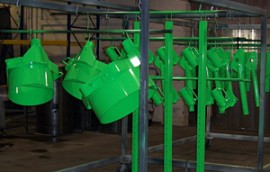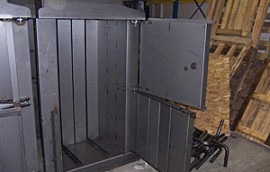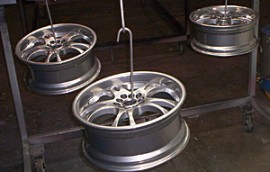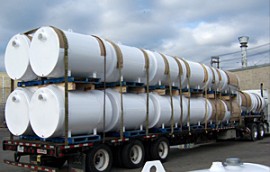The powder coating process
Valley Powder Coating maintains the highest standards for quality throughout every step of our process. The result is a finished product that you can be proud to offer your customers.
The basic steps of the Valley Powder Coating process are:
- Part preparation
- Pre treatment
- Racking
- Drying-off
- Masking and Plugging
- Applying the Powder Coating
- Curing
- Inspection and Packaging
1. Part Preparation
Before we coat anything, we put it through an extensive preparation process to ensure the best results for you.
We use a variety of chemical and mechanical methods to remove oil, grease, soil, metal oxides and other impurities to prepare parts for powder coating. The cleaning method depends on the type of soil to be removed and the the size, material and function of the part to be coated.
2. Pre-treament
The key to our quality is our thorough and meticulous pre-treatment process. Our process utilizes chemicals and abrasive blasting to clean parts, protect against corrosion and improve bonding of the powder to the metal.
For our chemical pre-treatment, we submerge or spray the parts with phosphates, often in several stages to degrease, etch, de-smut, and rinse.
Our abrasive blasting pre-treatment is ideal for metallic materials. The blasting cleans, degreases and prepares the surface and provides texture, etches, and finishes the parts for coating.
We offer a variety of blasting abrasives, depending on the chemical composition, density, shape, size and impact resistance of the part:
- Glass abrasives are sensitive to substrates such as aluminum, but still suitable for de-coating and surface finishing. Glass bead blast media uses glass beads of various sizes.
- Sand blast media uses high-purity crystals that have low-metal content.
- Glass bead blast media uses glass beads of various sizes.
3. Racking
Once the parts have been properly prepared and carefully pretreated, we set everything on racks for the next phease of the process.
4. Dry-off Oven
An important stage in the process is conveying the parts through our dry-off oven, to ensure that no moisture remains on them that can compromise the finished product.
Masking and Plugging of machined surfaces, threaded holes and studs
We mask and plug all machined surfaces, threaded holes and studs to ensure that the finished parts will assemble according to your exact specifications.
5. Powder Application Processes
Next we apply the power coating using an electrostatic gun. The gun imparts a positive electric charge on the powder and sprays it towards the workpiece with a positive electric charge. We offer a variety of nozzle types to best suit the contours of each workpiece and the consistency of the powder.
The grounded workpiece attracts the charged powder and holds it in place while it is heated. The powder melts into a uniform film and forms a hard coating when it cools.
6. Curing
After spraying, we cure the coated pieces in a convection oven, normally at 200°C for 10 minutes. Crosslinking, as this step is called, melts the powder to form a tough polymer that resists chipping, fading, abrasion and corrosion. We can also apply a zinc rich epoxy primer before the topcoat to even further extend the life expectancy of your products.
7. Inspection and packaging
The final step before we deliver the finished product to you is a thorough inspection of the parts to ensure they meet our high quality standards. Then we carefully package the completed order for quick delivery to your plant or office.
Valley Powder Coating is conveniently located in the heart of Winnipeg for speedy delivery anywhere in the city, the province, or even the continent.





